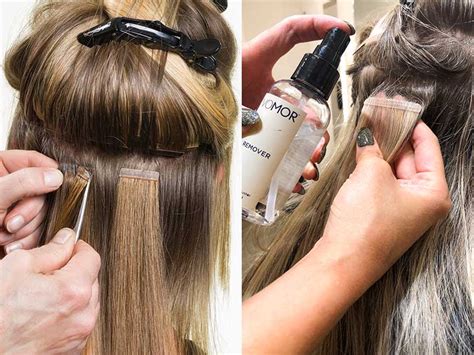Tape extensions are a popular hair extension method due to their natural appearance and ease of application. However, removing them can be a daunting task if not done correctly. This guide will provide you with five effective tape extensions removal solutions, empowering you to remove your extensions safely and efficiently.

1. Oil-Based Removal Solution
- Method: Apply a generous amount of oil-based remover, such as coconut oil, almond oil, or baby oil, to the tape bonds.
- Mechanism: The oil penetrates the tape bonds, breaking down the adhesive and softening it.
- Caution: Avoid using excessive amounts of oil, as this can make the hair greasy and difficult to manage.
2. Alcohol-Based Removal Solution
- Method: Dip a cotton ball or swab in isopropyl alcohol and gently rub it over the tape bonds.
- Mechanism: The alcohol dissolves the adhesive, separating the tape from the hair.
- Caution: Use 91% or higher isopropyl alcohol for optimal results. Avoid using on dry or brittle hair, as it can cause further damage.
3. Professional Removal Solution
- Method: Visit a professional hair stylist who specializes in tape extension removal.
- Mechanism: Stylists typically use a combination of techniques, including steam and special solvents, to dissolve the adhesive and safely remove the extensions.
- Benefits: Professional removal ensures proper technique and minimizes the risk of hair damage.
4. Heat-Assisted Removal Solution
- Method: Hold a blow dryer or heat gun on low heat and gently blow over the tape bonds.
- Mechanism: The heat softens the adhesive, making it easier to slide the extensions out of the hair.
- Caution: Keep the heat at a low setting and avoid overheating the hair, as this can cause damage.
5. Steam Removal Solution
- Method: Steam the tape bonds using a steamer or a clothing iron set to a low steam setting.
- Mechanism: The steam penetrates the adhesive, breaking it down and making it easier to remove the extensions.
- Caution: Protect the hair from direct steam contact by using a towel or heat-resistant barrier.
Choosing the Right Removal Solution
The best tape extensions removal solution depends on your individual hair type, the type of tape used, and the length of time the extensions have been in. Here’s a quick guide:
- Thick, coarse hair: Use an oil-based or professional removal solution.
- Thin, delicate hair: Use an alcohol-based or steam removal solution.
- Extensions less than 6 weeks old: Use an oil-based or alcohol-based solution.
- Extensions over 6 weeks old: Use a professional or heat-assisted removal solution.
Pain Points in Tape Extensions Removal
- Hair breakage: Improper removal techniques can cause hair breakage.
- Scalp irritation: Adhesive residue or harsh chemicals can irritate the scalp.
- Time-consuming: Removing tape extensions can take several hours, depending on the method used.
Motivations for Proper Tape Extensions Removal
- Maintain hair health: Safely removing tape extensions minimizes hair damage.
- Avoid scalp issues: Proper removal prevents scalp irritation and potential infections.
- Enhance future hair extension applications: Cleanly removing extensions allows for seamless reapplication, without adhesive buildup.
Why Tape Extensions Removal Matters
- Prevents hair loss: Improper removal can lead to hair breakage and thinning.
- Reduces scalp irritation: Leaving adhesive residue on the scalp can cause itching, redness, and inflammation.
- Ensures future extension success: Cleanly removed hair provides a good foundation for future extensions.
Benefits of Proper Tape Extensions Removal
- Preserves hair health: Prevents breakage and maintains hair integrity.
- Protects scalp: Removes adhesive residue and prevents scalp irritation.
- Facilitates reapplication: Clean removal allows for easy reapplication of extensions without adhesive buildup.
Table 1: Comparison of Tape Extensions Removal Solutions
| Method | Mechanism | Benefits | Cautions |
|---|---|---|---|
| Oil-Based | Penetrates adhesive | Natural, gentle | Can make hair greasy |
| Alcohol-Based | Dissolves adhesive | Quick, effective | Avoid on dry hair |
| Professional | Combination of techniques | Safe, efficient | Requires professional expertise |
| Heat-Assisted | Softens adhesive | Quick, convenient | Avoid overheating hair |
| Steam | Penetrates adhesive | Gentle, reduces breakage | Protect hair from direct steam |
Table 2: Pain Points in Tape Extensions Removal
| Pain Point | Symptoms | Causes |
|---|---|---|
| Hair breakage | Splintered hair shafts | Excessive force or improper technique |
| Scalp irritation | Itching, redness | Adhesive residue or harsh chemicals |
| Time-consuming | Hours of removal | Extensive adhesive bonds or thick hair |
Table 3: Motivations for Proper Tape Extensions Removal
| Motivation | Benefit |
|---|---|
| Maintain hair health | Minimize hair breakage |
| Avoid scalp issues | Prevent irritation and infections |
| Enhance future hair extension applications | Allow for seamless reapplication |
Table 4: Benefits of Proper Tape Extensions Removal
| Benefit | Impact |
|---|---|
| Preserves hair health | Prevents hair loss and breakage |
| Protects scalp | Reduces scalp irritation and inflammation |
| Facilitates reapplication | Enables easy reapplication of extensions |
Conclusion
Removing tape extensions safely and effectively is essential for maintaining hair health and ensuring future extension success. By understanding the different removal solutions and choosing the right method based on your hair type and extension lifespan, you can prevent pain points and reap the benefits of proper removal. Remember,
